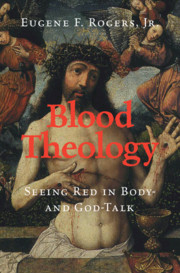Book contents
- Blood Theology
- Reviews
- Blood Theology
- Copyright page
- Dedication
- Contents
- Acknowledgments
- Part I Why We See Red
- Part II Blood Seeps in Where It Hardly Seems to Belong
- Part III Blood Makes a Language in Which to Conduct Disputes
- 5 Bridegrooms of Blood
- 6 Red in Tooth and Claw
- 7 Blood Purity and Human Sacrifice
- Part IV The Blood of God at the Heart of Things
- Appendix Review of Gil Anidjar’s Blood: A Critique of Christianity
- Sources Cited or Consulted
- Scripture Index
- Subject Index
7 - Blood Purity and Human Sacrifice
Castilians Meet Aztecs in War
from Part III - Blood Makes a Language in Which to Conduct Disputes
Published online by Cambridge University Press: 22 March 2021
- Blood Theology
- Reviews
- Blood Theology
- Copyright page
- Dedication
- Contents
- Acknowledgments
- Part I Why We See Red
- Part II Blood Seeps in Where It Hardly Seems to Belong
- Part III Blood Makes a Language in Which to Conduct Disputes
- 5 Bridegrooms of Blood
- 6 Red in Tooth and Claw
- 7 Blood Purity and Human Sacrifice
- Part IV The Blood of God at the Heart of Things
- Appendix Review of Gil Anidjar’s Blood: A Critique of Christianity
- Sources Cited or Consulted
- Scripture Index
- Subject Index
Summary
In Reconquista Spain, a barely united state turned its anxieties inward with anti-Semitic laws on blood purity among converts from Judaism and Islam. The same insecure state turned outward to conquer Mexico, where Franciscans spent fifty years recording Aztec human sacrifice in codices and color drawings. Castilians and Aztecs alike marked their external bounds and internal bonds with blood. Ethnicizing ideas of blood purity crossed the Atlantic to ruddy Christian perceptions of Mesoamerican sacrifice. Two blood-obsessed cultures met to reveal disturbing resonances in Christian blood language. Uses Sircoff on limpieza de sangre and Timothy Radcliffe on cultic irony in Hebrews.
Keywords
- Type
- Chapter
- Information
- Blood TheologySeeing Red in Body- and God-Talk, pp. 161 - 182Publisher: Cambridge University PressPrint publication year: 2021

